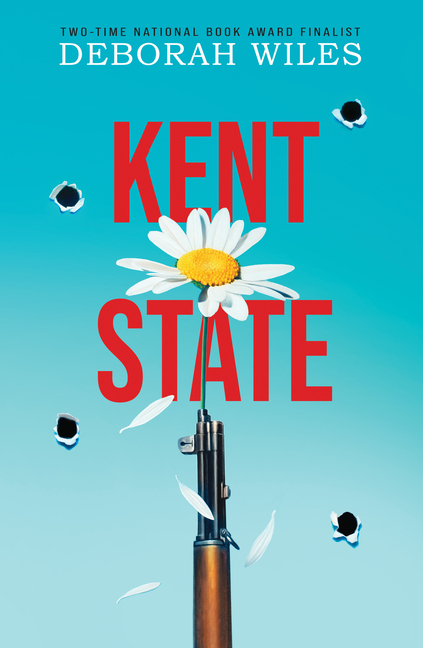
Book Resume
for Kent State by Deborah Wiles
Professional book information and credentials for Kent State.
7 Professional Reviews (4 Starred)
5 Book Awards
Selected for 3 State/Province Lists
See full Book Resume
on TeachingBooks
- School Library Journal:
- Grades 7 - 10
- Publisher's Weekly:
- Ages 12 and up
- Kirkus:
- Ages 12 and up
- Booklist:
- Grades 7 - 10
- TeachingBooks:*
- Grades 7-12
- Word Count:
- 15,981
- Lexile Level:
- 640L
- ATOS Reading Level:
- 5.3
- Genre:
- Historical Fiction
- Year Published:
- 2020
7 Subject Headings
The following 7 subject headings were determined by the U.S. Library of Congress and the Book Industry Study Group (BISAC) to reveal themes from the content of this book (Kent State).
- College students--Juvenile fiction
- Vietnam War, 1961-1975--Protest movements--Juvenile fiction
- Kent State Shootings, Kent, Ohio, 1970--Fiction
- Universities and colleges--Fiction
- Kent State Shootings, Kent, Ohio, 1970--Juvenile fiction
- Novels in verse
- Vietnam War, 1961-1975--Protest movements--Fiction
7 Full Professional Reviews (4 Starred)
The following unabridged reviews are made available under license from their respective rights holders and publishers. Reviews may be used for educational purposes consistent with the fair use doctrine in your jurisdiction, and may not be reproduced or repurposed without permission from the rights holders.
Note: This section may include reviews for related titles (e.g., same author, series, or related edition).
From Horn Book
Starred review from May 1, 2020
On May 4, 1970, four students were killed by the National Guard on the campus of Kent State University during a protest against the Vietnam War and the bombing of Cambodia. Wiles, author of Countdown (rev. 5/10) and other titles in the "documentary novel" Sixties trilogy, recalls the heart-wrenching event in somber free verse. The book's structure is unusual: disembodied voices, differentiated by typeface, representing disparate campus constituencies as well as the "townies" of Kent, Ohio, engage in a passionate imagined conversation. After a concise prelude that summarizes America's involvement in Vietnam, two voices welcome the reader, offering to share "what we remember / so it won't happen again." They are revealed to be two former Kent State students, and are soon joined by a local couple angry at the "commie hippie pinko" student agitators; members of the National Guard; and others. All bicker and lay blame, but eventually sincerely wish that the murdered students "rest in peace." Notable among the voices are the weary members of the Black United Students group, who are sadly familiar with white authoritarian violence; and the Guard's volunteer soldiers, many of whom were just teenagers themselves. The -format -effectively captures the pain, confusion, and conflicting perspectives of the time while also making direct connections to current acts of gun violence and governmental overreach. The equally absorbing author's note, full of fascinating research forays and information about 1960s protest songs, should not be skipped. Jennifer Hubert Swan
(Copyright 2020 by The Horn Book, Incorporated, Boston. All rights reserved.)
From School Library Journal
April 1, 2020
Gr 7-10-The Kent State shootings are recounted in poems voiced by the affected, from students to townspeople to the National Guard. Chaotic and contradictory, the narrative reflects the atmosphere on campus and in the nation. Each voice has its own font, but the identity of the speaker is not always clear. "Lament" introduces the four dead students and mentions the nine wounded. The events of the weekend are covered day by day as students' anger rises, they act out, and the National Guard is called in, culminating with the shootings on May 4th. "Elegy" ties the shooting to past and present atrocities urging readers "to be informed citizens." The phrase "Insert Your Name Here" in bold print is sprinkled in the May 4th and Elegy sections, which is distracting, but also forces readers to engage in the events. The townspeople, National Guard, and Black United Students are the only clearly defined narrators. The font for the townspeople is the smallest, making it easy to overlook. The prelude explains the impact of the Vietnam War on the U.S., and the author provides detailed information on the research and writing process at the end. VERDICT The use of multiple voices captures the tumult of the Kent State campus and varying perspectives on events, but can make the story difficult to follow at times. A good general purchase.-Tamara Saarinen, Pierce County Library, WA
Copyright 2020 School Library Journal, LLC Used with permission.
From Publisher's Weekly
Starred review from March 16, 2020
Via many perspectives, this powerful free verse work explores the Kent State University shootings that shocked the U.S. in May 1970. Wiles (the Sixties Trilogy) sets the stage with a narrative prelude that contextualizes the campus unrest alongside the draft and seemingly unwinnable Vietnam War, and details how the incursion into neutral Cambodia further escalated tensions. The narrative begins as a lament and immediately draws the reader into the events with voices from varied points of view, including students, townspeople, the National Guard, and the Black United Students of Kent State. Font, size, and spacing set off the distinct, often conflicting, perspectives, thoughtfully underscoring each. Wiles divides the text into the four days leading up to the shootings, and eulogizes each of the four massacred students. The black students' voice proves particularly poignant in its depiction of long-standing institutionalized racism, and Wiles effectively portrays the combustible and enduring controversies that led to this tragedy. Ending with an extensive author's note, this hard-hitting historical novel provides valuable perspective on unrest and violence, both timely and timeless, and an invitation that speaks to the present: "We hope you're/ on fire/ for change." Ages 12â€"up.
From Kirkus
Starred review from February 15, 2020
A free-verse treatment of the killing of four college students during campus protests over the Vietnam War. College campuses were often flashpoints in the struggle against the United States' involvement in the Vietnam War. In May 1970, protestors at Kent State University in Ohio were met by the Ohio National Guard, culminating in the deaths of four unarmed college students and injuries to nine others. The university and the small town surrounding it were all affected by the escalating tensions and disagreement over how to handle the issues. The governor's strict approach was welcomed by some but resisted by many on campus. Each of the deceased students is described in detail, including how they came to be in the line of fire. Readers hear from a guardsman and a town resident as well as students, their voices showing how perspectives differed depending on individuals' roles. Especially compelling are the words of black students, many of whom stayed away from the demonstration, believing, correctly, that the guardsmen had live ammunition. The structure serves to re-create the taut atmosphere of the days leading up to the tragedy, and various perspectives are represented by different fonts and typeface, furthering the sense of polarization. The extensive author's note extends the narrative, engaging readers in the author's process and the story's impact. A well-researched and deeply moving portrait of an iconic moment in U.S. history. (Verse novel. 12-18)
COPYRIGHT(2020) Kirkus Reviews, ALL RIGHTS RESERVED.
From Booklist
Starred review from January 1, 2020
Grades 7-10 *Starred Review* History records that on May 4, 1970, four students at Kent State University in Kent, Ohio, were shot and killed by members of the Ohio National Guard during a campus demonstration against the U.S. bombing of Cambodia. This is the story of that day and the three days of unrest preceding it. Wiles tells her story through unattributed voices of students and townspeople, of National Guardsmen, of Black and white individuals, of all those involved. To differentiate the voices, they are set in various typefaces and arranged on the page in columns, evoking a kind of call-and-response. The voices often meld into a deliberately confusing cacophony, reflecting the lingering uncertainty over certain details of those four days; rumors remain, and it is often forgotten, for example, that nine other students were injured on May 4. Wiles lists their names as well as those of the four who were killed: Sandy Scheuer, Bill Schroeder, Jeff Miller, and Allison Krause. She writes movingly about them and their short lives and brings a visceral energy to the events of the tragedy. In her account, Wiles implicitly challenges her readers to find parallels between then and now and, in so doing, does a service to history. An important book not to be missed.(Reprinted with permission of Booklist, copyright 2020, American Library Association.)
From Horn Book
January 1, 2020
On May 4, 1970, four students were killed by the National Guard on the campus of Kent State University during a protest against the Vietnam War and the bombing of Cambodia. Wiles, author of Countdown (rev. 5/10) and other titles in the "documentary novel" Sixties trilogy, recalls the heart-wrenching event in somber free verse. The book's structure is unusual: disembodied voices, differentiated by typeface, representing disparate campus constituencies as well as the "townies" of Kent, Ohio, engage in a passionate imagined conversation. After a concise prelude that summarizes America's involvement in Vietnam, two voices welcome the reader, offering to share "what we remember / so it won't happen again." They are revealed to be two former Kent State students, and are soon joined by a local couple angry at the "commie hippie pinko" student agitators; members of the National Guard; and others. All bicker and lay blame, but eventually sincerely wish that the murdered students "rest in peace." Notable among the voices are the weary members of the Black United Students group, who are sadly familiar with white authoritarian violence; and the Guard's volunteer soldiers, many of whom were just teenagers themselves. The �format �effectively captures the pain, confusion, and conflicting perspectives of the time while also making direct connections to current acts of gun violence and governmental overreach. The equally absorbing author's note, full of fascinating research forays and information about 1960s protest songs, should not be skipped.
(Copyright 2020 by The Horn Book, Incorporated, Boston. All rights reserved.)
From AudioFile Magazine
Fifty years after four young people were shot by the National Guard at Kent State University, Deborah Wiles gives us an honest fictional account enhanced by this production. The narrators give voice to several witnesses, each with a unique perspective. We hear the truth as perceived by students, townies, the National Guard, and others. Christopher Gebauer, as Student #1, uses a calm, steady voice to defuse the impatient anger of the activist student, portrayed by Lauren Ezzo. The insistent tone of Korey Jackson as a member of the Black United Students provides historical context. Christina Delaine and Johnny Heller, as townies, speak with hurt and confusion of dissension they don't understand, and Roger Wayne, as the Guardsman, adds an important perspective. N.E.M. Winner of AudioFile Earphones Award © AudioFile 2020, Portland, Maine
5 Book Awards & Distinctions
Kent State was recognized by committees of professional librarians and educators for the following book awards and distinctions.
3 Selections for State & Provincial Recommended Reading Lists
Kent State was selected by educational and library professionals to be included on the following state/provincial reading lists.
United States Lists (3)
Arizona
- Grand Canyon Reader Award, 2022 -- Teen Recommended List
Pennsylvania
- Pennsylvania Young Reader's Choice Award, 2021-2022, Young Adult
South Carolina
- Young Adult Book Award, 2021-2022, Grades 9-12
Preview Digital Book
Explore Kent State on Marketplace. Access requires OverDrive Marketplace login.
This Book Resume for Kent State is compiled from TeachingBooks, a library of professional resources about children's and young adult books. This page may be shared for educational purposes and must include copyright information. Reviews are made available under license from their respective rights holders and publishers.
*Grade levels are determined by certified librarians utilizing editorial reviews and additional materials. Relevant age ranges vary depending on the learner, the setting, and the intended purpose of a book.
Retrieved from TeachingBooks on February 03, 2025. © 2001-2025 TeachingBooks.net, LLC. All rights reserved by rights holders.


 Amelia Elizabeth Walden Award, 2009-2024, Finalist, 2021
Amelia Elizabeth Walden Award, 2009-2024, Finalist, 2021
 Best Fiction for Young Adults, 2011-2024, Selection, 2021
Best Fiction for Young Adults, 2011-2024, Selection, 2021
 Junior Library Guild Selections, 2012-2025, Audiobooks Selection, 2021
Junior Library Guild Selections, 2012-2025, Audiobooks Selection, 2021
 Odyssey Award, 2008-2025, Winner, 2021
Odyssey Award, 2008-2025, Winner, 2021
 Horn Book Fanfare, 2001-2024, Selection, 2020
Horn Book Fanfare, 2001-2024, Selection, 2020
